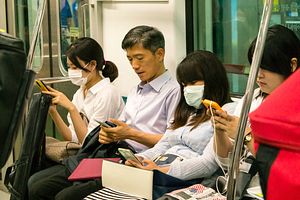South Koreans are avoiding department stores, cinemas, and baseball games in droves because of Middle East Respiratory Syndrome (MERS), which has killed 10 people and infected more than 120 in the country.
On Wednesday, government estimates showed huge drops in ticket sales at cinemas, museums, art galleries, and baseball grounds for the first week of June, with some attendances plummeting by more than 80 percent. Public fears were also manifested in department store sales, which fell by over a quarter, according to the same data reported by Reuters.
Morgan Stanley has predicted that the public anxiety could zap the country’s annual GDP growth by 0.15 percent if it continues until just the end of June. Such predictions spooked the Bank of Korea enough for it to slash the key interest rate to a record low of 1.5 percent on Thursday.
For many Koreans, skipping the popcorn and giant coke to avoid an incurable, potentially fatal virus must seem like a no-brainer. But if their health is a concern, they’d be better off trading in their car for a subway pass: 4,647 Koreans were killed in traffic accidents alone last year.
After dumping the car, they might also consider giving up crossing the road: the number of pedestrian deaths in the country in 2011 was almost three times the OECD average, with 4.1 fatalities for every 100,000 people in a population of some 50 million people.
Despite blanket coverage in the local media, MERS doesn’t even come within spitting distance of the list of the top 10 biggest causes of death, which in South Korea includes cancer, coronary disease, road accidents, respiratory conditions, and suicide. Since the first reported deaths from MERS on June 1, cancer alone has killed several hundred people — not in total, but every single day.
Paul Slovic, a professor of psychology at the University of Oregon, told The Diplomat that people react disproportionally to smaller risks like MERS because of the fear of the unknown.
“We know a fair amount about why people react differently to one hazard than another and why those reactions don’t track closely the statistical risks,” he said. “With driving, we are very familiar with it and we are very comfortable with it because from the time we are driven home from the hospital as infants we are in cars and, fortunately, most of the time those trips are safe, comfortable trips.”
Statistics tend not to impact perspective as well as real-life experiences, Slovic added.
“We know that people don’t go around a lot thinking about the statistics directly. It’s often hard to put the statistics in perspective. What they do know is whether they are fearful or worried about something. If you see people wearing masks, it’s kind of frightening in itself,” he said, referring to the trend of many South Koreans donning face masks to avoid infection.
Mark Zastrow, a Seoul-based science writer for Nature and New Scientist, said that the media reporting on MERS risks overstating the threat by focusing heavily on side outcomes like schools closures and economic losses.
“As a science journalist, one of the recurring themes is, ‘How do we communicate uncertainty?’ MERS is something that… does have uncertainties. There are unknowns about it,” he said.
“But…we can quantify them in terms of number of cases contracted, where those cases have been contracted and, yes, comparing the number of people who contracted MERS on the subway to the number of people who have died crossing the street. That’s absolutely a legitimate comparison and I think a very useful one.”

































